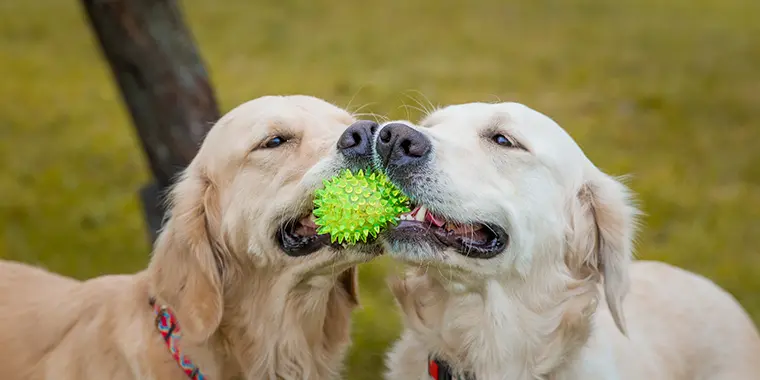
A humorous look at how dogs handle property rights:
- If I like it, it’s mine.
- When it’s in my mouth, it’s mine.
- If I can take it away from you, it’s mine.
- Did I have it a while ago? It’s mine.
- If it’s mine, there will never be a chance it could be yours.
- Once it’s chewed up, all parts are mine.
- If it looks like it’s mine, it is.
- If I see it first, it’s mine.
- After you put something aside you played with, it automatically becomes mine.
- If it’s broken, it’s yours.
And this is how dogs handle property rights!
How This Actually Works
I hope you enjoyed this but let’s take a quick look at how dogs actually handle conflict over resources. Dogs use dominance and submission behaviors to negotiate conflict without going to war.
Dominance and Submission
Dominance and submission are terms defined by ethology, not dog trainers. To explain these, we have to take a brief look at their origin.
When wolf puppies grow up, they develop fifteen main behaviors (nine dominance behaviors and six submission behaviors) that will help them negotiate with other wolves during conflicts over resources without resorting to a bloody battle. These are essentially escalation (dominant) and de-escalation (submissive) skills to settle disputes. The dominance behaviors develop first, and the submission behaviors develop after, all during the maturation of the wolf puppy. This is a very important fact to remember when we get back to dogs.
The main dominant behaviors are growling, displacing, standing over, inhibited biting, standing erect, body wrestling, aggressive gaping, baring teeth, and staring.
The main submissive behaviors are muzzle licking, looking away, crouching, submissive grinning, passive submission, and active submission.
During a conflict, wolves use these escalation and de-escalation skills to negotiate over resources. It will look scary, but none of that is actual aggression or fighting. It’s the attempt to avoid a fight, not start one.
How This Works in Dogs
This works in the same way with dogs, but dogs don’t go through the entire developmental cycle of a wolf. They stop somewhere in the middle, and how far they mature varies by breed. Developmentally, dogs are wolf puppies. The only dog breed that has all fifteen negotiation skills is the Siberian Husky. In contrast, the Cavalier King Charles Spaniel only has two.
As these skills develop in sequence, dog breeds with nine or fewer skills have essentially no de-escalation skills. This explains the poor social behavior of many dog breeds.
Generally, the more a dog breed looks like a wolf, the broader its negotiation skill set will be. If you want to read more about this, I highly recommend the study Paedomorphosis Affects Agonistic Visual Signals of Domestic Dogs by Deborah Goodwin and Temple Grandin’s book Animals Make Us Human.
In summary, dominance and submission behaviors are negotiation skills to avoid actual aggression (i.e., fighting). Consequently, the term ‘dominance-aggression’ is flawed, as when aggression begins, dominance and submission have failed to avoid a fight.
More dog fun at Reader’s Digest Dog Jokes




